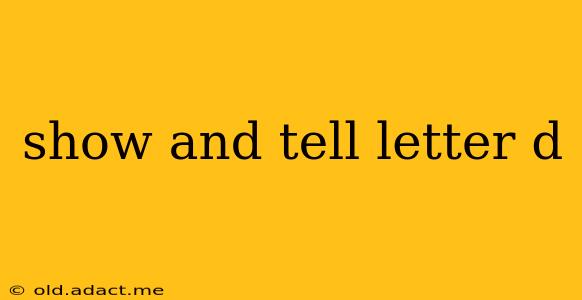This guide delves into the fascinating world of the letter "D," exploring its various forms, sounds, and significance across languages and cultures. Whether you're a teacher preparing for a show-and-tell session, a parent helping a child with their homework, or simply curious about this ubiquitous letter, this comprehensive guide will provide you with ample information and engaging activities.
What Does the Letter "D" Look Like?
The letter "D" is easily recognizable thanks to its distinctive shape. It's a closed curve with a straight line extending from it, often described as a circle with a tail. This simple form is consistent across many alphabets, although minor stylistic variations exist depending on the typeface (like Times New Roman, Arial, or Comic Sans). Consider showing different typefaces to illustrate this point. Children can even trace and color different examples of the letter D to grasp this variation.
What Sound Does the Letter "D" Make?
The most common sound "D" makes in English is a voiced alveolar plosive. What does that mean? It means your vocal cords vibrate when you produce the sound, and you briefly block the airflow in your mouth using your tongue against the ridge behind your upper teeth (the alveolar ridge). The sound is different from the unvoiced "T," which uses the same tongue and teeth position, but without vocal cord vibration.
You can demonstrate this difference by having children say "d" and then "t" repeatedly, noticing the difference in the vibration in their throats.
How Does the Sound of "D" Vary Across Languages?
While the sound of "D" is relatively consistent across many languages (including Spanish, French, German, and many others), there are subtle variations. For instance, in some languages, the pronunciation might involve a slight aspiration (a puff of air) or a different tongue placement. These subtle differences are less important for a show-and-tell focused on younger children but are interesting points for older children or adults.
Words That Start with "D": A Show-and-Tell Showcase!
Gather some objects beginning with the letter "D" for your show-and-tell session. Here are some ideas:
- Dog: A toy dog or a picture of a dog.
- Doll: A favorite doll.
- Dinosaur: A dinosaur toy or book.
- Door: A small door from a dollhouse or a picture of a door.
- Desk: A miniature desk or a picture of a desk.
This visual representation is key to making the letter D come alive for children. Encourage them to describe the objects, further reinforcing the letter's sound and visual representation.
What are Some Fun Facts About the Letter "D"?
- The letter "D" holds the position of the fourth letter in the English alphabet.
- The letter "D" is also a common abbreviation for words like "Doctor" or "Day."
- In Roman numerals, "D" represents 500.
These intriguing facts can spark curiosity and make the show-and-tell session even more engaging.
Activities to Make Learning the Letter "D" Fun:
- D is for Drawing: Encourage children to draw things that start with "D."
- D is for Decorating: Decorate a large "D" with colorful markers, crayons, or paint.
- D is for Discovering: Create a scavenger hunt focusing on objects that start with the letter "D."
These hands-on activities cement learning and encourage engagement. Varying the activities will help cater to different learning styles.
By incorporating these elements into your show-and-tell, you can transform a simple letter into an engaging learning experience. Remember to keep it fun, interactive, and visually stimulating for optimal learning.
